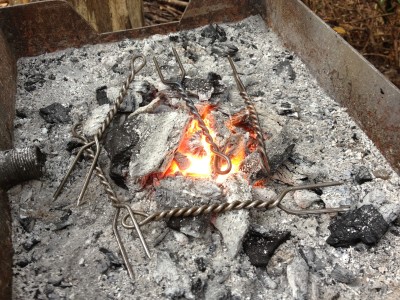10 Tips for Beginner Blacksmiths
As it was a skill I had wanted to acquire for quite some time, I began blacksmithing a little less than a year ago. Of course, I’m still a newbie and learn each time I fire up the forge. Though honestly, I hope that when I have been doing this for ten years I am still learning. Progress is my goal here.

Despite my newness, I have acquired a few tidbits I wish someone had shared with me (or I had listened to…I did hear one or two of these) when I started. So for all of you beginner blacksmiths, especially those who have yet to strike, this is for you. If you are doing your homework, hopefully you can learn from my mistakes and rough patches. And do note that some of these are only applicable with a coal or charcoal forge.
1) Get your stock hot! – Heat it to at least dark orange. I, like most beginners, was super excited to hammer, so I pulled it out way too soon. Barely cherry red is not a good forging temperature and is good for little other than putting hammer marks on your stock. This can be useful if you’re finishing a piece and going for a “hammered” look, but it is fairly worthless when it comes to any sort of shaping. Resist the urge, and leave it in the fire a little longer. You’ll be less frustrated in the end. And heads up – you can break poorly heated stock if you use too much hammer force.
2) Don’t fall for the “you can’t really see the glow in the sun” myth. – True, you will be able to see the metal glow better if your forge is in a dark place, a.k.a. inside. But even if you are working outdoors, as I do, you should still be able to see glow. Use your hand or your body to create a shadow to get a more accurate observation, but forge temperature is, at very least, dark orange even in direct sunlight.
3) Tend to your fire. – Yes, timing is crucial to shaping metal, and you have now realized the true meaning of the old adage “strike while the iron is hot”, but if you can’t get your iron hot, striking is really pointless. If you don’t tend your fire, it will burn out, and the burn out will probably sneak up on you. I recently did a very large project that involved 118 pieces. I struck a great rhythm but unfortunately didn’t work the fire tending in as well as I should. I ended up, having to empty the forge and completely restart. That was a half hour/hour completely wasted.
4) Empty your ash trap. – A clogged ash trap will send sparks flying everywhere. Yes, your fire is going to spark. Yes, it’s going to pop on you, but if it looks like one of those “golden shower” glorified sparklers that law-abiding citizens shoot off at 4th of July instead of the real fireworks, you probably have a backup somewhere.
5) Have a shovel handy. – Especially if you’re outside near leaves or other combustibles. Sometimes, fires pop out. Or perhaps you’re focused on the next step and not on your fire, so rather than turning the airflow down, you increase it! (Stop and digest that for a second.) Whatever the reason, coals end up a foot or two away from the forge on top of some leaves. You’re going need to do something about it pronto.
6) Keep your tools accessible. – Put them in the same place every time…unless that place just isn’t working. Then, find another spot. If you are searching around for a tool after you’ve removed a piece from the fire, it’s cooling, and you’re losing precious time.
7) Strike a rhythm. – I return to blacksmithing is all about good timing. Striking well heated stock at the right time yields more results than all the muscle power in the world. Find what works and replicate.
8) Brush fire scale away from you! – Fire scale is a black coating that forms on hot stock as its temperature changes. It is a form of oxidation. It’s flaky, and you need to brush it off because you don’t want it popping on you when you hammer. You also don’t want it left on your finished piece. It pits the surface and makes the finished product very rough. I have a few pieces I didn’t brush well, and they don’t look pretty. Use a welding brush to get rid of it. However, be sure you brush it away. It’s easy to make this mistake on a curved surface. Fire scale is hot and metallic, meaning when it hits your skin it sticks. When you finally get it off your skin, you will probably be bleeding.
9) Quench slowly. – This is not only a safety tip for you but also for the metal. Remember that heat drives molecules further apart while cooling brings them closer together. What happens if you stick a super hot jar in ice water? It shatters. Metal will do the same, and while you’re probably not getting your stock hot enough to create such an explosion, cooling too quickly will weaken the piece and make it brittle. Heating and cooling your stock can also strengthen it if done correctly. Unfortunately, I am not accomplished enough to give you those recipes. Someday…
10) Have fun making mistakes. – I know this is very general, but don’t be too hard on yourself. You’re a beginner, not a professional. I have to remind myself of this constantly because I do like my work to be quality. That said, so what if it didn’t turn out right? Try again. You’re not making a living doing this…and if you are, you’re not a beginner and just reading this for giggles anyway.
Leave a Reply